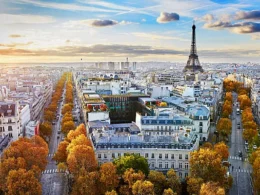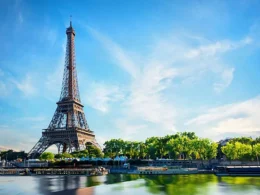Discover the rich history and architectural marvels of France’s Gothic cathedrals in this comprehensive guide.
The intricate craftsmanship and towering spires of these cathedrals have captivated visitors for centuries, serving as a testament to the ingenuity and devotion of the medieval builders.
This guide delves into the origins and evolution of Gothic architecture in France, highlighting the distinctive features and engineering achievements of these monumental structures.
From the iconic Notre-Dame de Paris to the awe-inspiring Chartres Cathedral, each cathedral’s unique characteristics and historical significance are explored in depth.
Whether you are an architecture enthusiast, a history buff, or a traveler seeking cultural immersion, this guide offers an insightful journey through the heart of France’s Gothic heritage.
History of Gothic Architecture in France
The history of Gothic architecture in France can be traced back to the 12th century with the construction of the influential Abbey Church of St. Denis. This marked the beginning of a new architectural style that would later influence the construction of iconic cathedrals such as Notre-Dame de Paris and Chartres Cathedral.
The Gothic style was heavily influenced by the Romanesque architecture that preceded it, but it also incorporated new design elements such as pointed arches, ribbed vaults, and flying buttresses. Over time, the Gothic design evolved, with architects and builders experimenting with different techniques and pushing the boundaries of engineering and design.
This evolution led to the creation of increasingly grand and elaborate structures that defined the skyline of medieval France and continue to awe visitors to this day.
Characteristics of French Gothic Cathedrals
Influencing the architectural landscape of France, French Gothic cathedrals are characterized by their soaring heights, intricate stained glass windows, and ornate sculptures. These cathedrals showcase the following distinctive features:
- Pointed arches: A defining characteristic of French Gothic architecture, pointed arches allowed for taller and more spacious interiors compared to Romanesque architecture.
- Flying buttresses: These external arched supports not only provided structural reinforcement but also allowed for the inclusion of large stained glass windows, creating a sense of lightness and verticality.
- Ornate sculptures: French Gothic cathedrals are adorned with intricate sculptures, often depicting religious scenes and figures, adding to the grandeur and spiritual significance of these magnificent structures.
French Gothic cathedrals stand as enduring testaments to the ingenuity and artistic prowess of medieval craftsmen and architects.
Iconic French Gothic Cathedrals
French Gothic cathedrals are renowned for their architectural grandeur and historical significance, with approximately 80 such cathedrals spread across France. Some of the most iconic French Gothic cathedrals include Notre-Dame de Paris, Chartres Cathedral, Reims Cathedral, Amiens Cathedral, and Bourges Cathedral.
These architectural marvels are characterized by their towering spires, intricate stained glass windows, and imposing flying buttresses. Each cathedral showcases unique elements that have served as artistic inspiration for countless generations. The delicate tracery, ribbed vaults, and ornate sculptures found within these cathedrals have influenced artists, architects, and designers around the world.
The iconic French Gothic cathedrals stand as enduring testaments to the ingenuity and creativity of medieval craftsmen, and they continue to captivate visitors with their timeless beauty and spiritual significance.
Significance of French Gothic Cathedrals
Renowned for their architectural grandeur and historical significance, the Gothic cathedrals of France hold immense cultural and religious importance.
These magnificent structures have had a profound influence on art, serving as a significant inspiration for countless artists and craftsmen throughout the centuries.
Their intricate designs and soaring spires exemplify the pinnacle of medieval engineering marvels, showcasing the remarkable skills and innovation of the craftsmen and builders of that era.
Additionally, these cathedrals have played a vital role in shaping the cultural identity of France, symbolizing the power and influence of the Catholic Church in medieval society.
Their enduring presence continues to captivate visitors and scholars alike, offering a tangible link to a rich and storied past.
Frequently Asked Questions
How Did the Construction of French Gothic Cathedrals Impact the Surrounding Communities and Economy?
The construction of French Gothic cathedrals significantly impacted surrounding communities and spurred economic development. These grand architectural projects created demand for skilled labor, attracting workers and artisans, and stimulated trade and commerce, enhancing local economies.
What Are Some Common Misconceptions About French Gothic Cathedrals and Their Architecture?
Misunderstood architecture and historical significance are common misconceptions about French Gothic cathedrals. They are not solely places of worship but also impressive feats of engineering and art, reflecting the innovation of their time.
Are There Any Lesser-Known or Underrated French Gothic Cathedrals That Are Worth Visiting?
Hidden gems among French Gothic cathedrals include Saint-Étienne de Cahors, Laon Cathedral, and Saint-Pierre de Beauvais. These architectural marvels face preservation challenges but hold immense cultural significance, making them worthy of a visit for enthusiasts.
How Have French Gothic Cathedrals Been Affected by Modern-Day Preservation Efforts and Restoration Projects?
Preservation challenges faced by French Gothic cathedrals are being addressed through modern restoration projects. These efforts aim to safeguard the architectural evolution of these historic structures, ensuring their longevity and cultural significance for future generations to appreciate.
What Role Do French Gothic Cathedrals Play in Contemporary French Culture and Society?
French Gothic cathedrals hold contemporary relevance, as cultural symbols and societal landmarks. Their architectural myths and preservation challenges contribute to their cultural significance. They serve as underrated gems, influencing tourism and the economy, with restoration successes preserving their legacy.










